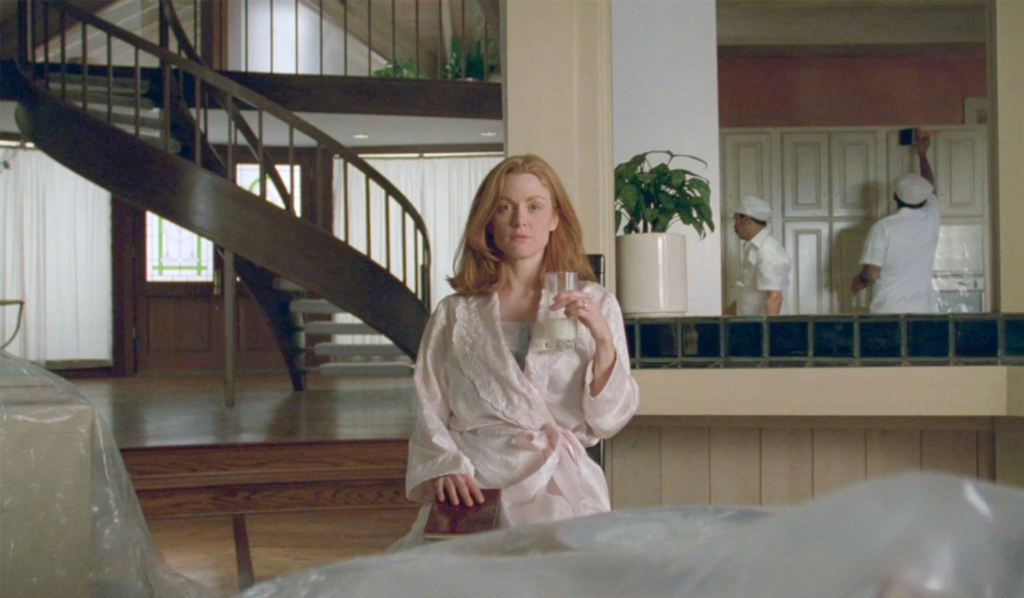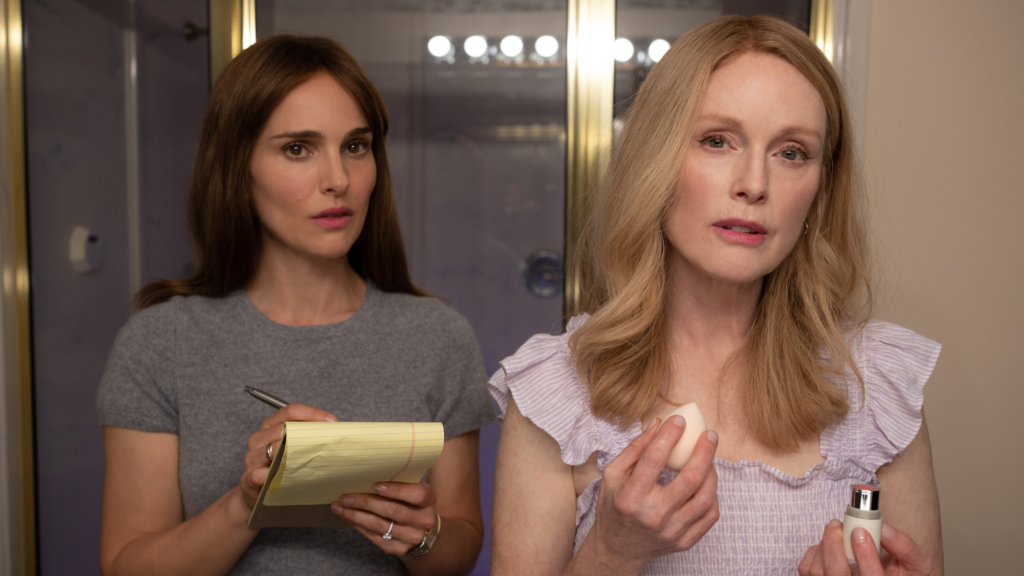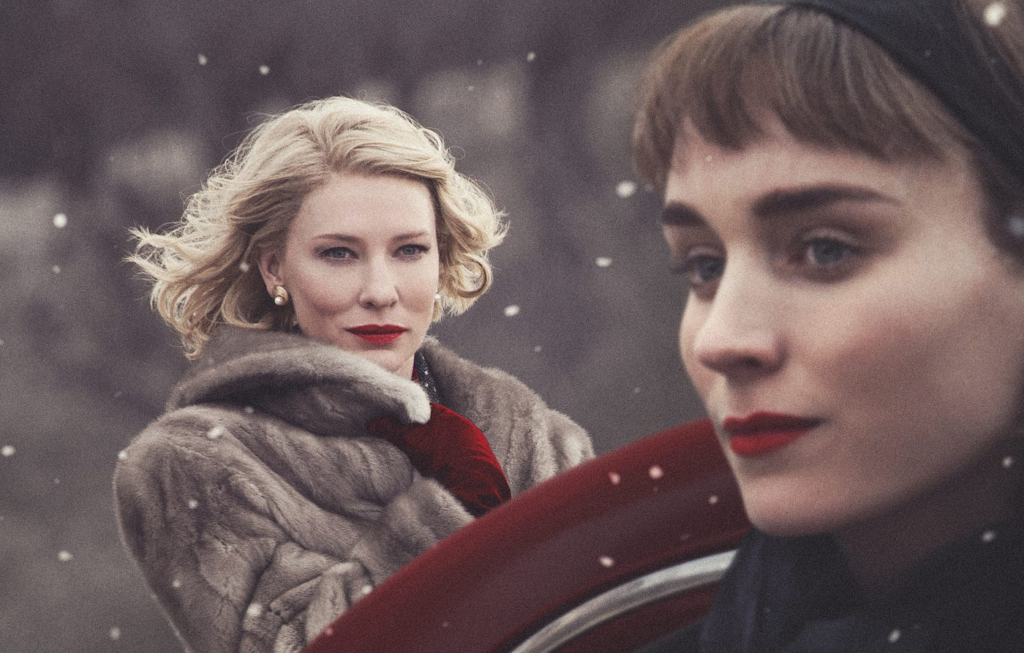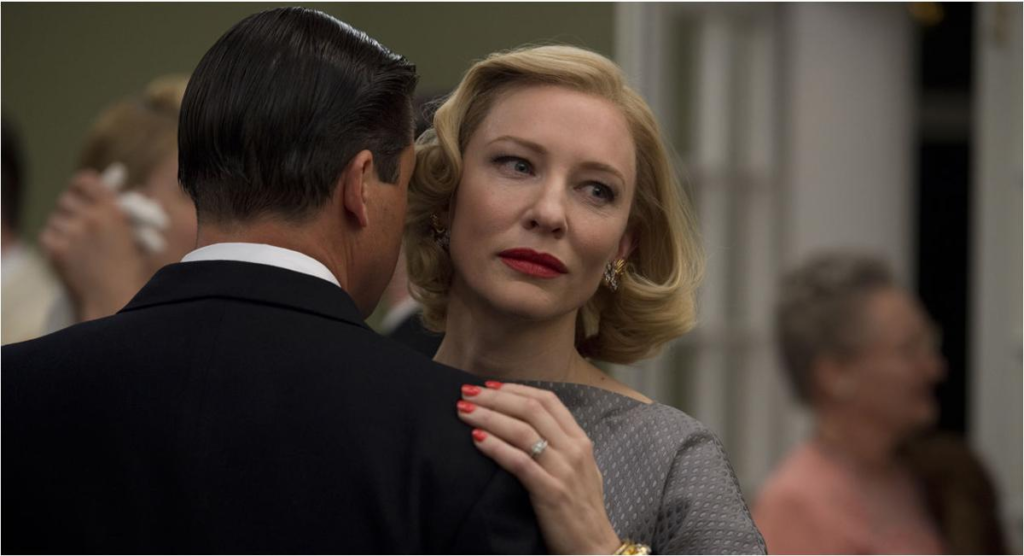Women are angry, scared, confused, and trapped. Women are decaying behind gorgeous floral arrangements, beautiful tapestries, and original paintings. Women are slowly fuming at baby showers, morning cocktail hour, or gossip by the pool -separated from the eyes of the public. Women are withering, not like flowers, but like bodies craving adventures beyond safely calculated lives and planned Sunday dinners. Todd Haynes understands women more than any other male filmmaker, or at least he’s on the Mount Rushmore of male directors who “get” women without fetishizing their suffering or manicuring their pretentious gatherings as fun. There are many Carols in Todd Haynes’s prickly cinema, where the pioneer of the Queer New Wave wanted to create his own aesthetic and dialectical imprint by introspecting what goes on behind closed doors in the luxurious suburbs of America. He used his “Carols” to investigate the lives of women, probably hiding behind a simple name as Carol to bring forth a subconsciously imprinted image of a White, blonde (or redhead) woman, looking out of the window beautifully and suffering in silence.

Armed with a perfect mise-en-scène, Haynes derived his 1995 film Safe using the socialites drowning in wealth as his protagonists. The film stars Carol (Julianne Moore), the concubine wife, whom her wealthy husband married -apparently- to show off to his peers and therefore criticizes her whenever she fails to fill the void represented by her role, such as in the scene in which she dozes off during dinner with his friends, and when she refuses to have sex with him because she is incapable of doing so. He again reprimands her for her failure as a wife and a homemaker in this spacious estate that he gave her. The difference is evident in the uncomfortable opening scene of the couple having sex. As the husband reaches climax, Carol looks cold, far from orgasm. Her husband does not notice her needs while selfishly demanding her to satisfy his in the aforementioned scene in which she fails to have sex.
At first glance, Carol looks like a Barbie doll that many women aspire to become. But at a closer look, she is a dull person, unsuccessfully trying to make jokes, demanding authority in the most “polite” manner but failing to exert her power, even as the lady of the house. Her quiet voice, neutral tone, and slim build do not help her much. Carol tries to understand herself, eaten up by open-ended questions or tormented with guilt over an illness that has no root or cause. Her suffering is reflected in her frail body, and her beautiful, expressionless features until it becomes her only defining trait.
Carol is a difficult protagonist to understand. She is not an oppressed woman in the definitional sense of the word, nor a strong woman holding the reins of her life and psychological affairs. She is also unable to understand her existential crisis, which Haynes analyzes through an omniscient lens, the knowledgeable narrator looking from the outside without interference, perhaps except for using a moving camera forward, which suggests Carol’s confinement in her picture-perfect world, as she struggles to get by what were once mundane daily life routines, unable to change or run away from them.

The women of the 2023 film May December are not much different, as they both operate from different realms and work through different perspectives of the female experience. While Elizabeth Berry (Natalie Portman) is the narcissist, opportunist actress, thriving in attention while coyly pretending to dismiss it, Gracie (Julianne Moore) is a beautiful monster, masquerading as a caring, loving member of a suburban community, while secretly using her manipulative skills to prey on the beautiful butterfly that she trapped in her manor house; her husband Joe (Charles Melton).
Both have bodies as frail and thin as butter paper, and Haynes doesn’t shy away from shooting them as they engage in their feminine mystique activities. As Gracie stages her melodramatic breakdowns every night in the safety of her bedroom with a mostly compliant Joe, Elizabeth boasts her sultry descriptions in front of a mirror or recreates scenes in pet stores’ stock rooms. Haynes creates this anti-fairytale feverish dream, in which light and darkness intersect to frame characters in silhouettes and haze. Like Jack Ketchum’s The Girl Next Door and Richard Yates’s Revolutionary Road, Haynes’s suburban shimmering Gothic dream hides a monster story underneath, one in which the princess damsel holds an even more vulnerable prince captive, to feed on him every night. The contrast between light and darkness, the lavender-like, floral colors that Gracie dresses in create a huge contrast to the film’s darker, more sinister plot, and the inhibited emotional growth that Joe endures daily.

In the case of Cathleen or Cathy in the 2002 film, Far From Heaven, the female protagonist is oppressed and overpowering at the same time. She oppresses her gay husband to stay with her, to deny his truth, to accept the world of a happily married, heterosexual American suburban couple. He, in turn, oppresses her through his mistreatment of her, his dismissal of her existence, his disregard for her house activities, and her desperate attempt to maintain the picture-perfect image. He doesn’t try once to acknowledge her plight. Haynes designs the film in the same style as Douglas Sirk’s classics. For example, he uses classical music and bright melodramatic tones to express too clearly the ambiguous relationships between the characters. Still, unlike Sirk’s films, Haynes’s color palette in Far From Heaven highlights the extent of disharmony between Cathy (Julianne Moore) and her husband (Dennis Quaid). When they are away from each other, searching for love in American bars that do not belong to their class, Haynes’s use of the color green shows that despite their different paths, the couple feels the same guilt stemming from their pursuit of forbidden love.

On another note, the 2015 film Carol plays like an anti-Christmas movie, working against type as most of these films take advantage of the beauty of the scenery and decorations in Europe and America during the Christmas season. In Carol, Haynes uses Christmas decorations to besiege Carol (Cate Blanchett) in the empty house and a failed marriage; it seems as if the Christmas ritual is a dreary routine shackling Carol in colorful chains. She is more than a docile housewife making cakes and cookies to celebrate Christmas, but a passionate, ravenous lover seeking love that breaks her eternal suburban loneliness. On the other side of the world, Therese (Rooney Mara) also looks trapped in a toy store decorated for the Christmas season, or with comrades in bars where she is lonely in the middle of crowds. Both women are confined within worlds with too bright colors and mesmerizing interior design that only multiplies their misery and unfulfillment. Using symbolic objects like lipstick, wine glasses, Christmas trees, gloves, and fur coats, Haynes reserves passion for a selection of belongings, and items to revisit and haunt in dreams. Both Therese and Carol are haunted by one another, even if it seems as if only Therese is smitten by the dazzling Carol.
The beauty of the scenes and shots in Haynes’s films, -depicting the female protagonist trapped in her ideal velvet world- masquerades the horror of the upper class that takes shelter behind wealth and delicate household details.
Carol’s beautiful flower garden in Safe, Cathy’s in Far From Heaven, Gracie’s neat floral arrangements in May December, and the house filled with Christmas decorations and festivities in Carol are nothing but a forest that traps its protagonists and confines them to the space that narrows down on them like a noose, creating a backdrop to a façade of beautifying the ugly, and asserting control over a mess spiraling downward. Haynes dismantles the traditional heterosexual nuclear family system by rebelling against it, whether with the love story between two women in Carol or love between interracial relationships in Far From Heaven or by making a woman’s body rebel on itself in Safe.
In Safe, Haynes is interested in showing the confinement of Carol under her role as a wife and homemaker as her husband leaves every morning for work. The husband abandons Carol, thinking that he created a haven for her, but this idealistic mansion traps her in every frame, and through the wide-angle lens, in more than one scene the camera turns back as the dolly-zoom tightens the hold on Carol; the audience feels as if the camera’s proximity to her increases her distance from her world, not the other way around. Although Safe appears to be the least of Haynes’s films to shatter the modernist philosophy; with its traditionalism, an ordinary construct, and a clear, linear narrative line, the film’s time cycle connects in a circle, ending without salvation, solution, or a logical answer to anything that happened.
In May December, the spacious beach house in Georgia is a labyrinthine creature in which Gracie not only entraps her husband/boy toy but also her guests and her children. The arched windows and slanted ceilings provide a false sanctuary for Joe to entrap more butterflies and watch them fly away and for Gracie the ultimate Victorian-era lover to encase Joe within a layer of beauty and domesticity, to mother and nurse him to a crooked sense of adulthood, one that is based on meals provided to him hand to mouth, and insistence on his being the first one to eat a slice of her cake. There’s a humidity to the atmosphere that creates a sense of eternal summer like this house never knows winter –whether the metaphorical or the seasonal coldness. In a sense, Gracie differs from Haynes’s traditional heroines, in that she is the one inflicting the suburban cocoon on herself and her partner, smothering herself and the lover with love and tenderness, so that suburbia becomes her tool rather than her prison. Or rather it becomes like a prison of one’s own, like self-imposed isolation of those who were hurt too much by the outside world that their mere existence in it could cause harm.

In Carol and Far From Heaven, a catalyst pushes the safe woman away from her suburban domestic life to rebel and go out of the ordinary, throwing her home-bound life behind to seek love. Cathy always wears clothes that have a degree or a hue that blends in with the background or the set design. She appears as if she is in harmony with the surroundings like a good, docile 50s wife, but in reality, it makes her scarily trapped, lethally meshed to the fabric of the surroundings, if she wanted out, she would have to tear a part of her with it, abandoning all hope. Carol, on the other hand, is still the daughter of the same colorful times, but instead of glorifying it, glossing it over like pastel-tinted images in a magazine, Haynes chose to villainize the colors, making greens acidic, some dirty yellows and pinks, giving a seediness to the false suburban sense of safety evoked by well-furnished houses and decorated trees, manicured lawns, and cozy bedrooms.
Haynes perfects the use of camera angles, lighting, and color tones to express the women’s unhappiness or their appropriation of a moment of ecstasy and passion on the sidelines of their flashy lives, crowded with visual details that contribute to framing them according to certain masculine outlook -that of their husbands or lovers.
Haynes’s women are depressed, repressed, and outcasts in their subordinate existence on the peripheries of the lives of their husbands. He just happens to show that through a floral collection, a lens forgiving but unrelenting in this exposition of human misery.





